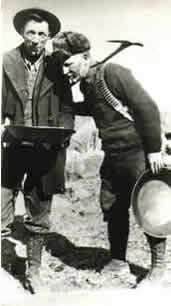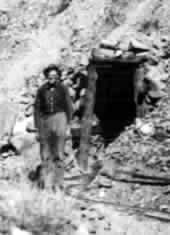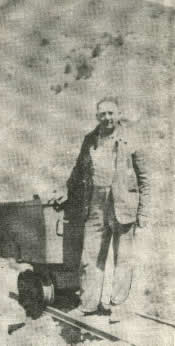

Asa Whitney
and Friend mining for gold on Snake River 1934

Jim Wheelock
standing by tunnel at his Connor Creek mine in 1930's

John Still,
Silver Still mining claim Miner canyon, Idaho 1936
Prospectors
Among the many enterprises to mine the river bottom, none were credited to be a success and Snake River went to her watery tomb in 1958, the victor of the spoils, still clutched in her bosom her precious Connor Creek gold.
The early prospectors were familiar with reports that the bars on Snake River between Connor Creek and the mouth of Powder River hoarded gold, from the size of a pin head to $10.00 and $20.00 nuggets. Golden grains of that size were frequently picked up with the primitive appliance of a pick, shovel, wheelbarrow, sluice, and rocker. When the water was low, which was often times the case, a miner could delve into the bars exposed by the low water and run the dirt through the rocker with magnificent results. When the river came up, the miners were forced to abandon the river bed and move back to the banks of the stream, which, while good paying ground, was nowhere equal to the river bottom.
Through the years much mining by this method was done in the Snake River near our ranch, These prospectors were aware that the gold bearing creeks through the natural erosion had carried much gold into the river. In the summertime when water was too scarce for the prospector to mine their placer claims on the dry, barren hillsides, they would flock to the river bank and pan the silt and sand for the precious yellow metal. In 1914 when I first came to live at our ranch, Frank Johnson, a Swede, was working in the river across from our place. He worked in water so deep that when he stooped to pick up gravel from the river bed to pan, his head went under water. He made big money mining but it went for booze. When Zena Johnson, his daughter, came from Sweden she was supposed to get off the train at Huntington, as he had made arrangements to meet her there, She couldn't speak English,and came on past Huntington to Baker, where Mrs. Bisher of Halfway found her and brought her to Richiand. She had her father's address at Richiand, and Mrs. Robinette took care of her, notifying her father of her arrival. He provided her a home and support from his mining.
A man by the name of Joseph Stewart was mining across the river from us, living in a dugout. Mr. Stewart got sick and Albert went over in a row boat, brought him to our place and gave him the only $10.00 we had and sent him out on the train to the county hospital in Weiser. In about a year he returned with our $10.00 and filed on a 640 acre homestead adjoining our homestead. After three years, with Albert's help, he made proof in 1928. Two weeks after making proof, he went to Weiser with Johnny Benson for his winter's food supplies, took the flu and died in the hospital there. Albert was made the administrator of his estate, paid all his bills and bought his homestead. Among his possessions was a big silver railroad watch which Albert had given to my brother, Don Sullivan, and was eventually passed on to my son Eylar. Eylar, although a child, remembers Mr. Stewart well. Mr. Stewart had been a prospector in Alaska and had a watch chain made of Alaska gold nuggets which he had with him in Weiser at the boarding house where he was staying when he took sick. This watch chain was never found. There was also a fellow who mined in the area named Parkhill, a boozer, who was reported to be the son of a millionaire.
Another prospector, William Smith, mined on the Idaho bank of Snake River south of the old Flick Bar diggins. In July of 1901, he was getting out coarse gold pieces worth $2.00 and wheelbarrows of pay dirt worth $5.00 a load. His claim was at Smith Bar on the Idaho side of Snake River across from our ranch. His find was a deposit of very coarse placer gold, with many very large nuggets. One nugget was worth $186.00 when gold was only worth $20.67 an ounce. This nine-ounce nugget was the largest nugget I have known to be found along the river. A facsimile of this nugget was on display at the United States National Bank in Baker, Oregon and may still be there. Smith, being very successful, became known to carry his small bottles of gold to Baker City to cash in. Contrary to some belief, gold was not carried in buckskin bags but in small bottles or tobacco cans. Smith, after displaying a large bottle of gold to some miner friends, took off for Baker City to cash in his hard labor. He never arrived in Baker City, nor was he ever heard from again.
Copyright
2006 by Lillian Cummings Densley
All Rights Reserved
All Rights Reserved